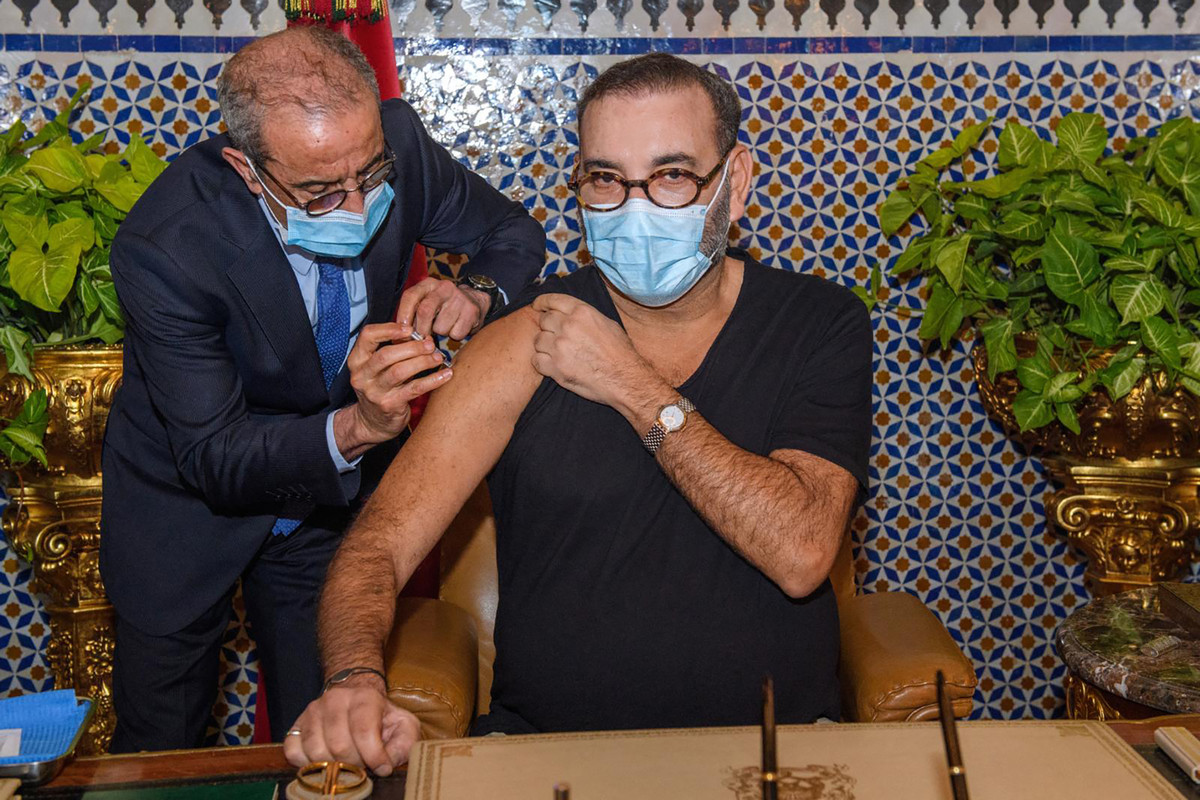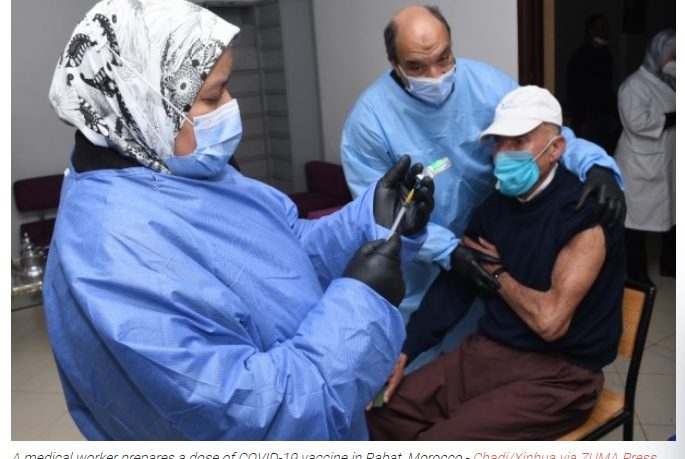WorldCrunch
The North African country was quick to react when COVID-19 first showed up and is now outpacing places like Germany in a rush to immunize its citizens.
TANGIERS — All they have to do is send a text, and a few seconds later Moroccans have their vaccine appointment. The country has overtaken Germany in the vaccination race. And while Europe is languishing in lockdown, life in Morocco is almost back to normal. What is the secret to their success?
Even from the street, the sign over the entrance to the Roi Fahd Health Center in Tangiers is clearly visible. “COVID-19” is written in the middle in large red letters, with pictures of syringes on either side. The pillars are festooned with flags bearing Morocco’s national emblem — two lions with a shield and crown and the five-pointed star, which represents life and health.
The healthcare facility, in the city’s Charf quarter, is one of 288 vaccine centers in the region. In the courtyard, people wearing masks stand in the shade of palm trees, waiting their turn to be vaccinated. Inside, the waiting room is also full — although people are of course observing social distancing. There’s no opportunity for the 30 staff members to take a breather. From morning until night, there is always a doctor or nurse in each of the three rooms, ready to administer the AstraZeneca COVID-19 vaccine.
Demand is high. “At first, some people had reservations, but when they saw that no one had side effects, they started to come,” says Dr Karima Reklaoui, the health center’s medical director. “Yesterday we administered 267 vaccinations, and today it could be 300, which is our maximum capacity.”
When asked about anti-vaxxers and coronavirus deniers, she gives a tired smile. “No, no, thank God — we don’t have any of that. You can’t take it seriously,” she says. “In Morocco people definitely want to be vaccinated.”
Everyone is tired of the restrictions and wants to return to normal life, the 50-year-old doctor explains. “And the vaccine is the only way to do that.”
Getting vaccinated has been made very easy for Moroccans. There are no hotlines to call or letters delivered by post. People send a text with their national ID number and a few seconds later they receive a message with a venue and appointment time. It couldn’t be simpler.
While Germany and its European neighbors are stumbling through the second wave, Morocco is well on the way to vaccinating itself out of the crisis. In Germany, the seven-day average for first and second vaccines is currently 126,806 per day. Last week Morocco administered an average of 173,920 vaccinations per day.
Morocco is often seen as an exotic holiday destination, but not a country with efficient national leadership. An assumption Europeans make about many African countries. But Morocco is way ahead of Europe at the moment. For a second time, we must admit, because throughout the pandemic it has been far more successful than its European neighbors.
No supply problems
On Jan. 28, in the royal palace in Fez, King Mohammed VI was the first to be vaccinated, sounding the starting gun for a national vaccination campaign. So far, 2.5 million Moroccans have had their first vaccination, in one of 2,888 centers. And every day the number grows by more than 100,000. Teachers, doctors, nurses, police officers and people over 75 have all been vaccinated already.
Morocco is well on the way to vaccinating itself out of the crisis.
Now it’s the turn of the over 65s. The aim is to vaccinate 80% of the adult population, which is 25 million people. If everything goes to plan, that could be achieved by the end of May. Morocco has secured 66 million doses of the vaccine.
Thus far there have been no supply problems like those experienced in Germany. In the last few weeks, AstraZeneca flew 6 million doses to Casablanca. A further million came from China, and the company Sinopharm will soon deliver more, as Morocco took part in the early trials of the Chinese vaccine.
The successful vaccine campaign shows once again that Morocco’s crisis management is robust. The country did experience a second wave in summer, but managed to control it through a clear strategy of time-limited measures, isolation and hygiene, all while placing a high level of trust in the population. Now the Moroccan Ministry of Health is registering fewer than 500 new infections per day, and around 10 deaths. Infections are going down. Those are numbers that Germany and made other EU countries can only dream of.
National strategy
“You can see it as a success story,” says Professor Hicham Sbai, sitting in his office at the medical faculty of the new Mohammed VI University in Tangiers. “Compared to other countries, Morocco’s reaction was faster, stricter and more proactive.” He explains that there was a national strategy from the beginning, with involvement from all institutions and stakeholders down to the regional level.

King of Morocco Mohammed VI receiving the COVID-19 vaccine — Photo: Niviere David/Abaca via ZUMA Press
The 43-year-old professor knows what he’s talking about. He is a senior doctor in the intensive care ward at the Duc de Tovar Hospital in Tangiers, which has 72 intensive care beds for COVID-19 patients. The neighboring Mohammed VI Hospital has another 40 beds. Professor Sbai is in regular contact with regional authorities and scientific committees.
“It has been and still is a joint effort from everyone involved in the fight against the virus,” he says. “From the king to the various ministries, hospitals and laboratories, down to the doctors and nurses who are treating patients.”
Going its own way
Morocco closed its borders on March 13 last year and stopped international flights when there were only four known cases of coronavirus in the country. The government also decided to close schools that same day. Shortly afterwards, the authorities declared a medical emergency, which lasted four months. A curfew was imposed from 6 p.m., and travel between cities was forbidden. All shops except supermarkets and chemists were ordered to close.
The authorities made face coverings mandatory from very early on, and stepped up mask production. The ailing public health system was also given a boost, with modern equipment sent to hospitals. Emergency clinics sprang up and vast amounts of medicine were made available.
Treatment centers on the malaria drug hydroxychloroquine and the antibiotic azithromycin. European doctors and scientists remain unconvinced about the efficacy of these treatments. “We’ve seen good results with them, and a low death rate,” says Professor Sbai.
One tool above all others has been most important in the country’s fight against the virus: contact tracing.
Contact tracing
Morocco is indeed going its own way, and its success speaks for itself. But one tool above all others has been most important in the country’s fight against the virus: contact tracing. It is at the heart of their anti-COVID measures.
“Whether it’s 10 people or 1,000, all an infected person’s close contacts have to self-isolate,” says Professor Sbai. “For serious cases we admit them to hospital, otherwise they can stay at home and they are monitored by the authorities.”
There are currently around 10,000 COVID-19 patients in Morocco. According to official statistics, there have been around 480,000 infections since the start of the pandemic.
The second wave
Last June many Moroccans thought the pandemic was over. On average there were only 152 new infections per day. The restrictions were being eased. The streets and parks were filling up again. “It was the same as in all other countries,” says Professor Sbai. “People got careless and what followed was a second, even bigger wave.”
But this time the government decided against going back into a hard lockdown. Instead they divided the country into different zones, and only introduced strict measures at a local level if it looked like the number of new infections in an area was getting out of control.
“As the numbers started to go up, contact tracing was the decisive factor again,” says Professor Sbai.
It may have taken two months to get the situation back under control, but without contact tracing it wouldn’t have been possible at all. “Today the situation is stable again,” Professor Sbai says, seeming almost relaxed. “Over the past six weeks or so, the number of patients in intensive care in Tangiers has been constant, at between eight and 10, and the death rate is going down.”
This week the government announced that the curfew would be extended for another two weeks. Shops, cafes and restaurants have to close at 8 p.m. From 9 p.m. until 6 a.m., the streets are empty. This latest curfew was introduced before Christmas, when the new strain from the UK was first identified and started to spread.
“The faster we vaccinate people, the sooner we can return to normality,” says Dr. Reklaoui. “We’ve been preparing for four months and now we can vaccinate as many people as possible.”
She is very pleased that so far no one has suffered from side effects. “Not a single case,” she says. “It comes down to the attitude. If someone is positive about vaccinations, they’re less likely to experience side effects than someone who is skeptical about them.”
Although her mouth is covered by a mask, you can see in her dark eyes that Dr. Reklaoui is smiling.







